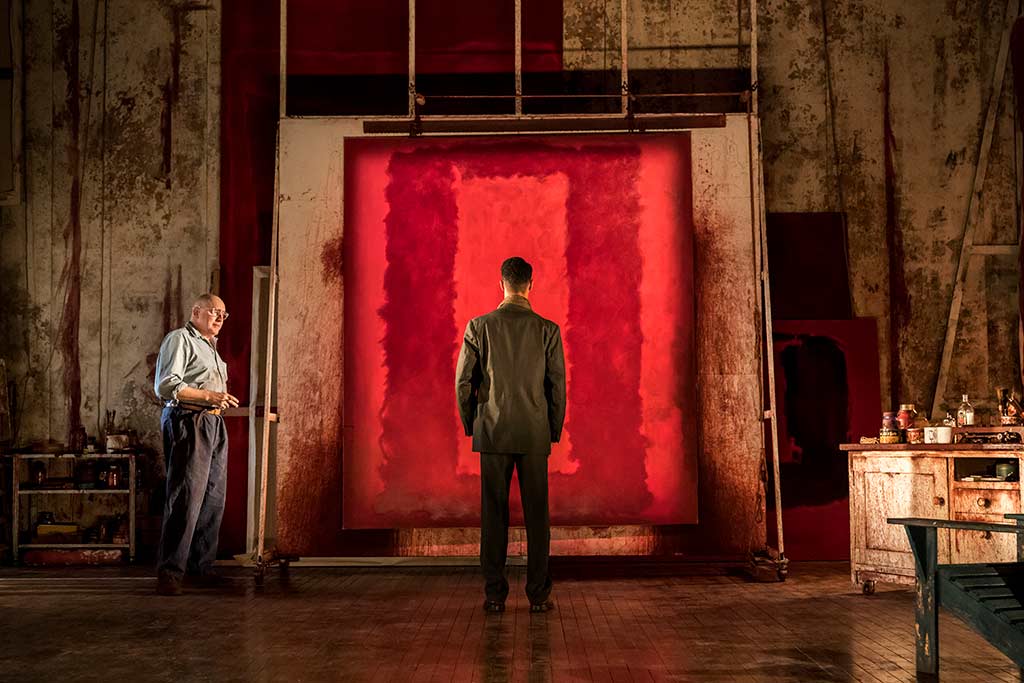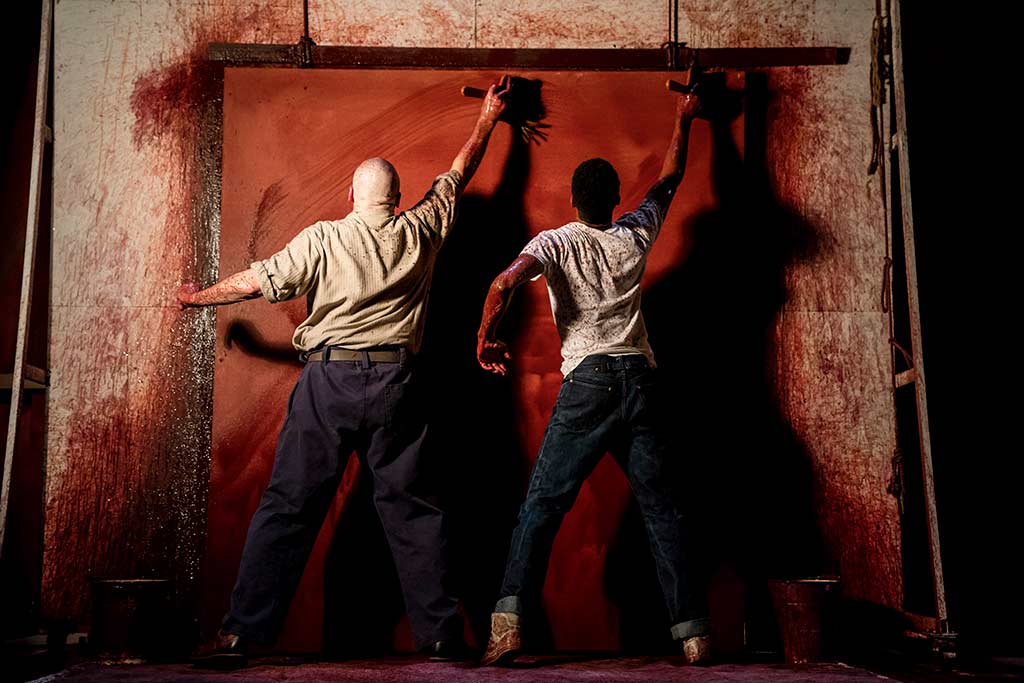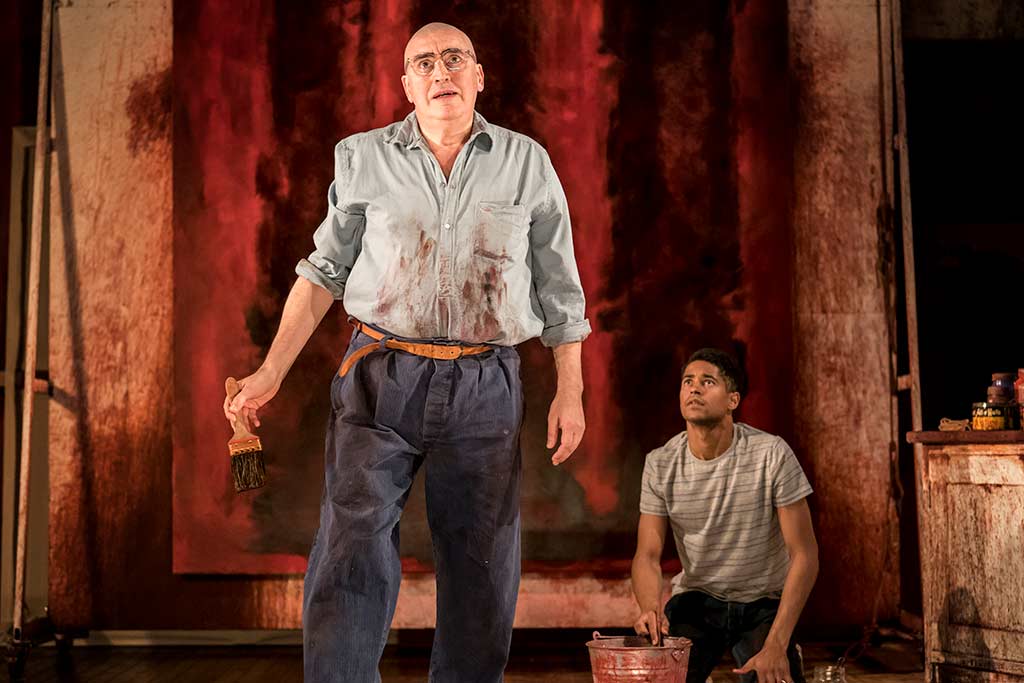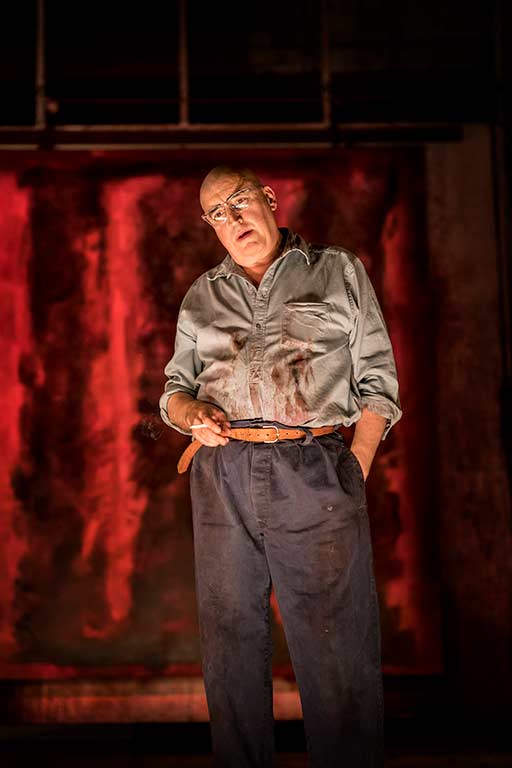Wait and See
The play titled Red on American artist Mark Rothko is a powerful exchange of ideas on the ways of seeing, and how within the spectrum of an individual there are multiple perceptions, if we only choose to see
Suzanne McNeill
As we take our seats for Red, a play about the American abstract expressionist artist Mark Rothko, the actor playing Rothko is already present on stage, sitting with his back to us in deep contemplation of one of his enormous paintings that is positioned to the back of the stage, and facing us. We shuffle along the narrow row, whisper about seat numbers, remove coats, stow bags, settle ourselves, while Rothko maintains his solitary study. The stage is set as the artist’s studio, lined with canvases waiting to be primed, half-finished works and tables cluttered with pigments, pots and brushes. A young man arrives suddenly on stage – the play has begun – yet the first interaction between him and Rothko is an imperious gesture by the artist commanding silence, before finally he speaks: ‘What do you see?’

Seeing, looking, contemplating – these are major themes in this two-hander play that covers a period of about two years at the end of the 1950s. The story is based on a series of real events. In 1958, Mark Rothko, now painting in his definitive style, was commissioned to produce a series of large paintings for the new Four Seasons restaurant in New York’s Seagram Building. Rothko’s idea, as he articulates in the play, was to paint ‘thirty or forty and then choose which work best, in concert, like a fugue.’ Later, he will refer to the Seagram murals (as they became known) as ‘a continuous narrative filling the walls’. The meaning and consequences of this commission are debated and played out by Rothko and Ken, an imagined character who comes to work for the artist. Fundamental questions about how art matters in society drive the play forward. Famously, Rothko was to withdrawfrom the commission, instead gifting the paintings to Britain’s Tate Gallery.
Red was written by John Logan (perhaps better known as the screenwriter of a number of Hollywood blockbusters, including the Bond films Skyfall and Spectre, The Aviator, The Last Samurai and Gladiator). He talks of how he was profoundly affected by seeing the Seagram murals at Tate Modern during the mid-2000s. ‘I took time to let the pictures work on me. Rothko is a painter that requires time and a certain generous emotional access. Then I read the description on the gallery wall about how and why the murals were painted. The whole play came to me in that instant.’

However, this is not only a play about how we view art. Logan’s staging makes the audience witness to the process of creation. Ken’s role is to ‘stretch the canvases and mix the paints and clean the brushes and build the stretcher and move the paintings …’ Ken also studies Rothko as the great man broods, rages, stomps, prowls and roams around his studio. There is a stunning moment of choreography at the mid-point of the performance when the two men work in rapid and intense symbiosis to prime one of the huge canvases. But there is disharmony, too. Rothko, after further scrutiny of one of the unfinished paintings, suddenly ‘sees’ what the next application of colour should be, but is frustrated by Ken’s mistimed and misjudged interjection when he says, ‘Red.’ ‘By what right do you speak?’ Rothko roars, slinging paint at his hapless assistant.
Played by Alfred Molina since the play first opened in 2009, Rothko is compelling and egocentric. Logan admits to being drawn to ‘dark, interesting characters’, and admires Rothko’s intensity and his seriousness. For Logan, the artist was ‘a combination of philosopher and poet. [There is] not a frivolous brush stroke on the canvas.’
This seriousness is explored in the performance. Rothko is meanly dismissive of the new generation of artists that Ken admires. Their names populate the dialogue – ‘… de Kooning and Motherwell and Smith and Newman and Pollock …’ For Rothko, modern Pop Art is trivial, disposable. He physically shudders at the name Warhol and expresses his horror that even he has become ‘a noun’, ‘a Rothko’, that his paintings are valued only as overmantles, ‘doomed to become decoration.’

For Rothko, the colour fields of the paintings that ignorant collectors are trying to co-ordinate with their interior design were of fundamental importance to understanding his vision. His weren’t the action-based abstracts of the so-called gestural expressionist artists he decried, such as Pollock, who energetically dripped, splattered and daubed paint onto the canvas. Instead, he carefully selected and placed colour, monochromatically or in blocks that were close in tonal value. The compositions were simple, and the art was created on a large scale. The paintings weren’t meant to be conventionally beautiful; they were intended to reach the sublime and to evoke an emotional response from the viewer. Red, that one word that incurs his displeasure in the context of Logan’s play, is not just red paint. It is the colour of sunrise, of blood, rust and fire. It is passion, life and joy, whilst black is annihilation. The interplay between light and dark on the canvases becomes an interplay between light and death. Logan, discussing his play, notes that Rothko’s overwhelming desire was ‘to capture something ineffable on canvas, and that is his tragedy.’ The not seeing.
In the context of Red, this is the ultimate failure. ‘Wait,’ Rothko tells Ken, ‘Stand closer. You’ve got to get close. Let [the painting] pulsate. Let it work on you …’ ‘Look at the tension between the blocks of colour,’ he yells at one point. Later, he tells Ken, ‘They’re in process. I have to study them.’
The audience studies them too, along with Rothko, along with Ken as he strives to understand Rothko’s vision. The paintings are moved around the set by the characters as they converse and argue. Here the role of lighting is particularly important to the performance. Rothko was obsessed with light, where it came from, how it changed the perception of his works. There is comedy in one of the play’s set-piece dialogues when Ken asks Rothko if he ever paints outdoors. ‘You mean out in nature?’ asks Rothko, ‘Nature doesn’t work for me. The light’s no good.’ A picture should be illuminated from within, he explains. On stage, the works are lit in different modes and as the play progresses we see this accomplishment of Rothko’s, how they come alive according to the different states of light upon them.

Controlling the light, displaying the paintings in a continuous narrative, evoking that emotional response – the physical environment in which the paintings are located is central to Rothko’s vision in Red, and here is the tension at the heart of the play. Rothko declares his desire ‘to create a place … where the viewer could live in contemplation with the work and give it some of the same attention and care I gave it […] a place of reflection and safety.’ He believes he is creating a sacred space, but Ken, now accustomed to Rothko and tired of his self-absorption, calls him out for the paintings are destined to be hung in a restaurant. Rothko may believe he’s making ‘a holy place of contemplative awe’, but in reality he’s ‘just decorating another dining room for the super-rich.’ He’s commodifying his own paintings, for the commission is the antithesis of everything Rothko believes.
The paintings never made it to the Four Seasons restaurant. Logan gives Rothko his longest speech in the play when he relives the humiliating visit he has just made to the restaurant in a driving, alliterative, almost unpunctuated monologue of frustration and anger set entirely in the present tense. It is the most powerful moment of the performance, the point at which Rothko’s ego is stripped bare and he himself ‘sees’ truly the hypocrisy of the venture for the first time. The performance ends as Rothko dismisses Ken, sending him out into the world beyond the confines of the studio, and the play, with the instruction ‘Make something new’ and, most importantly, ‘Make them look.’ Left alone on stage, he resumes his contemplation of his painting, now gloriously lit and pulsating with life.
All Photographs by Johan Persson.
Share